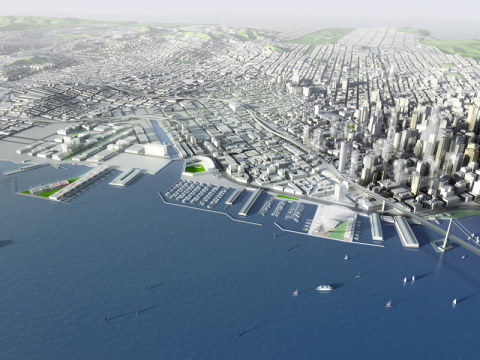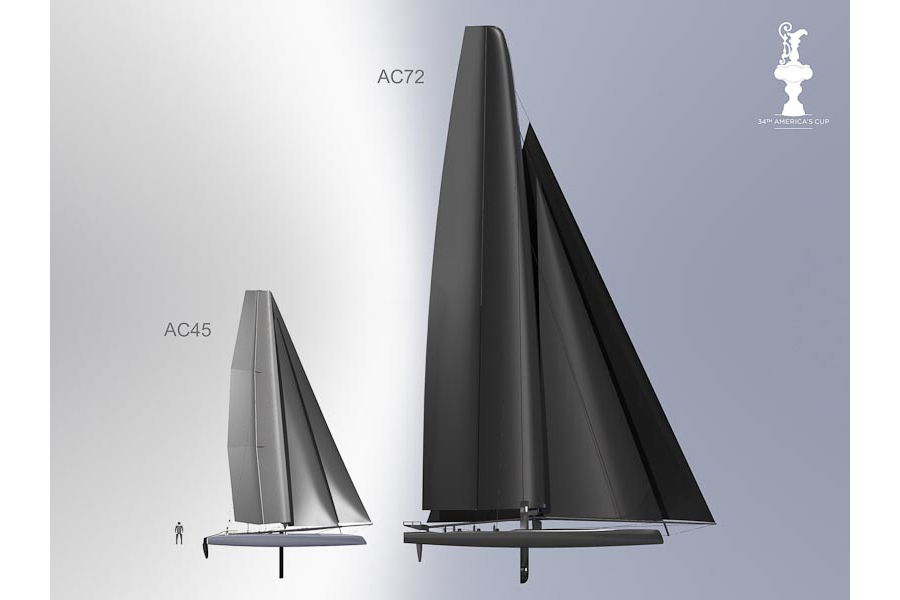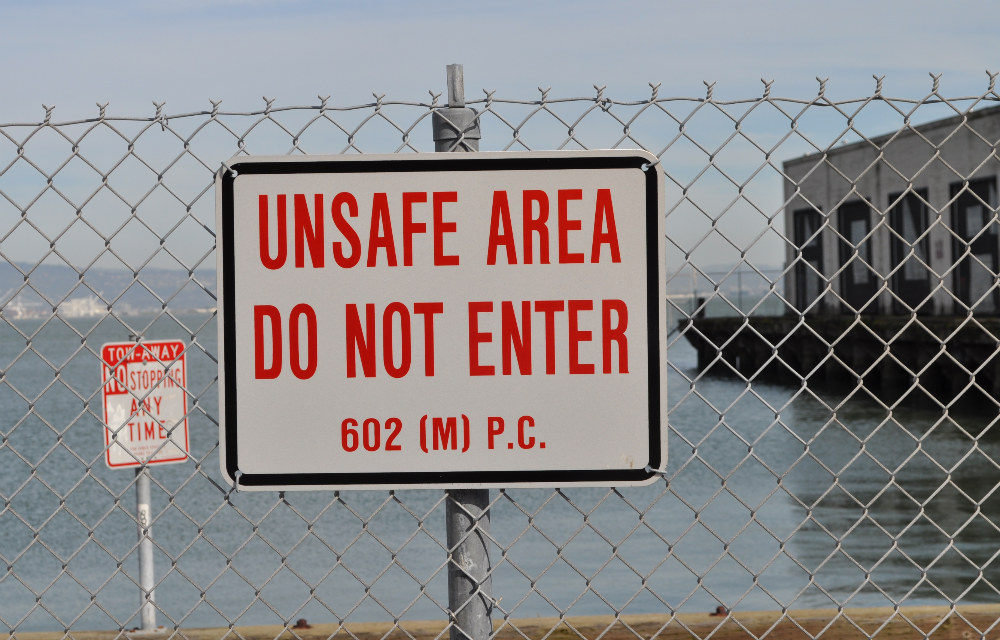Multihulls and More = AC 34
There is much to be absorbed in Monday’s announcements by the Defender and the Challenger of Record for America’s Cup 34. Beyond the anticipated headliner that 72-foot, wingsailed catamarans are the platform of choice, I note that the latest documents open up some wiggle room regarding venue. Gone is the draft language stipulating that the challenger eliminations will be sailed in the waters of the Match, replaced by—
Article 12:
(d) if there is a single Venue for the Match, the winner of each race in the Match scores one point, the loser scores no points, and the winner of the Match will be decided by the first yacht to score at least five points after applying any penalties;
(e) if there are multiple Venues for the Match, the format will be announced before or with the announcement of those Venues.
The way I read the tea leaves, this improves the odds of running the 34th America’s Cup match on San Francisco Bay—in 2013, not 2014, to my surprise—because it frees the organizers from dependence on this piece of infrastructure or that. The Protocol creates a World Series of America’s Cup sailing, with the AC Match as the centerpiece, and once you have a traveling road show, you have options.
 San Francisco’s proposed Cup Village. © 2010 Skidmore Owings & Merrill LLP
San Francisco’s proposed Cup Village. © 2010 Skidmore Owings & Merrill LLP
I don’t mean to suggest that the City of San Francisco is off-note with Mayor Gavin Newsom’s proposal for an ambitious overhaul of the southern Embarcadero. The teams want it, the waterfront needs the overhaul, there’s no other prospect out there for getting it done, and San Francisco partisans should not let the conversation be driven by worries over the next 75 years of usage. A grand, fully envisioned, fully realized America’s Cup village requires solid concrete pads topped with temporary structures. When the AC is gone (not soon, we hope), the city will be the better for having sound, revitalized infrastructure, and then we can have that conversation about the next 75 years.
 A new-look Embarcadero © 2010 Skidmore Owings & Merrill LLP
A new-look Embarcadero © 2010 Skidmore Owings & Merrill LLP
It’s a better look than what we see now . . .
And yes, Virginia, we can have a cup village ready in 2013. That was an important component of the most recent meeting between the team and the Mayor. But even if there’s a hiccup, the language of the Protocol opens a means to race the 34th Match on San Francisco Bay, which is the same as to say—
Let’s defend America’s Cup in America.
Monday’s press conference, streamed from the BMW Oracle Base in Valencia, Spain, included the formal signing of the Protocol by Commodore Marcus Young for the defending Golden Gate Yacht Club and Commodore Claudio Gorelli for the Challenger of Record, Club Nautico di Roma.
 Vincenzo Onorato, head of the Mascalzone Latino Challenge, Commodore Claudio Gorelli of Club Nautico di Roma, Commodore Marcus Young of Golden Gate YC, and Sir Russell Coutts
Vincenzo Onorato, head of the Mascalzone Latino Challenge, Commodore Claudio Gorelli of Club Nautico di Roma, Commodore Marcus Young of Golden Gate YC, and Sir Russell Coutts
Speaking to journalists after the press conference, Coutts said of San Francisco, “We’re looking for reliable wind conditions, and San Francisco Bay passes that test with flying colors. It’s a fantastic harbor. The course can run past landforms like Alcatraz and the Golden Gate, and I calculate that you could do three laps of the bay in 45 minutes. The city is right there and the airport is close. The Cup Village is ‘right there.’ But we have to also balance what is the level of support, which goes into the commercial return, and when things could be finished. It became clear recently that the venues could be ready by 2013, and right up front that cuts a team’s budget by 25 percent. Also, 2014 has World Cup Soccer right in the middle of the year. That would have been difficult to work around, especially if the venue is in Europe.”
I hear a message that, regarding venue, nothing is a done deal. But I see the Defenders doing what they can to bring the Cup match to San Francisco Bay.
NEW BUZZ
 BMW Oracle Racing has a prototype one-design 45-foot catamaran under way now, the first of a fleet of boats intended to launch the new regime. These are starter boats, if you will, to be raced in three events in 2011, and you can bet your bippy that San Francisco Bay is a strong contender for one of those slots. The plan is for declared teams (“at least eight challengers” according to BOR CEO Russell Coutts) to race against each other in the 45-footers through March of 2012, while they are building their 72-foot America’s Cup contenders. Subsequent racing moves to the 72-footers, with seven regattas in 2012.
BMW Oracle Racing has a prototype one-design 45-foot catamaran under way now, the first of a fleet of boats intended to launch the new regime. These are starter boats, if you will, to be raced in three events in 2011, and you can bet your bippy that San Francisco Bay is a strong contender for one of those slots. The plan is for declared teams (“at least eight challengers” according to BOR CEO Russell Coutts) to race against each other in the 45-footers through March of 2012, while they are building their 72-foot America’s Cup contenders. Subsequent racing moves to the 72-footers, with seven regattas in 2012.
And yes, there are potential candidates for a Defender elimination series.
THE ROAD SHOW
The changes for America’s Cup 34, Coutts said, ” Represent by far the biggest change in the history of the Cup. To be honest, we started off with this program thinking monohull, but the farther we went, the more the multihull made sense, and the more compelling the case became. We want to see the best sailors racing the fastest boats in the world. These boats will be cool. They will bring in a lot more of the sailors who have come up sailing skiffs and other high performance boats—it won’t look like the senior tour any more.”
 Vincenzo Onorato, Challenger of Record with the Mascalzone Latino team, and Russell Coutts, CEO of BMW Oracle
Vincenzo Onorato, Challenger of Record with the Mascalzone Latino team, and Russell Coutts, CEO of BMW Oracle
The 45s will fit inside containers. This, Coutts said, “Provides an elegant way to address moving the fleet around to different venues.” The 72s won’t fit into containers, but unlike V5 ACC monohulls, they can be broken apart and air-shipped in 747 cargo planes.
The Defender claims this will allow more new teams to be competitive. According to Coutts, “It will not be as expensive as running a team for AC 32 in 2007. Depending on the personality, you could get to 100 million euros, but you wouldn’t have to, to be competitive. The smallest teams could operate on a budget of 40 million euros. Personnel is the main driver, at least 60 percent of a team’s budget. The same is true in the NFL too. That seems to be about the number, so the AC is not that different.”
CHANGING THE GAME
“If you had asked us a week or two or even a month after the 33rd America’s Cup, we would have been thinking monohull,” Coutts said. “My concern was for the match racing side of the game, but when we went out and tried it, I was convinced that multihulls would be just fine for match racing, and possibly even more interesting.”
Strong consideration will be given to a short first leg, to bring the boats to the first mark close together. “That would mean that the boats would round nose-to-tail,” Coutts said, “so the race could be won downwind, which would be interesting from a competitive point of view, also from a spectator point of view. And if we end up in a high-wind area, a reaching leg would be worth considering because you’d see the boats at peak speed.
“Approaching marks in a high performance multihull, you really have to sail the boat to its optimum. If you alter course even in a small way, you lose a lot. It is harder for a boat in front to defend a lead position. Upwind and downwind that will be a major change, and I think you will see more passing.”
And where did those one-design 45-footers come from? “Our team did the design,” Coutts said. To complete the fleet, “We’re talking to various builders around the world. The first boat is due to be launched at the end of December, and we’ll invite teams to sail on the boat in New Zealand at some time in January . . . Strange as this sounds, I actually don’t know who is building the prototype.”
The 45-footers will eventually morph into “junior boats” on the circuit, but I don’t think anybody will be moving directly from Optis. Let’s think of them instead, post-2012, as a traveling venue for the farm teams.
THOSE 72-FOOTERS
Each team will be limited to building two of the 72-footers defined by the America’s Cup box rule, with a limit of four wings in eight sections, though Coutts suggested that four is an outside number and most teams will probably build only two wings. Being smaller than the wing on USA 17 that won the Cup in February, they will be inherently more manageable and will not require motor-driven winches. It seems likely they will be designed from the get-go to raise and lower easily, or perhaps they will mimic the Harbor Wing prototype, which is designed to pivot freely in two sections so as not to “sail” at rest. The BOR team shares brainpower with Harbor Wing, so there are no secrets there.


